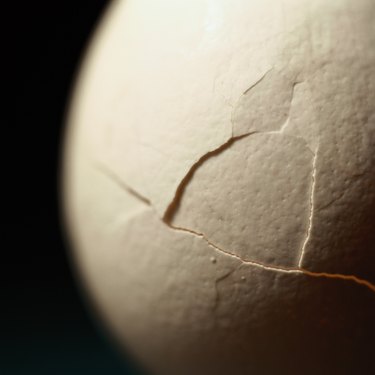
Sauce polonaise, or sauce prepared in the style of Poland, belongs to the group of classical dishes informally referred to as "Frenchified" preparations, or classical French dishes comprised of ingredients common to a country, city or region made using the French cooking technique. Sauce Polonaise consists of eggs, parsley, butter and breadcrumbs cooked just until the flavors combine. Sauce Polonaise has a textured consistency, so you don't pour it as much as you spread it.
Breadcrumbs, Butter, Eggs and Parsley
Video of the Day
Polonaise is one of the simpler French sauces, in both technique and ingredients. Breadcrumbs, butter, hard-boiled eggs and flat-leaf parsley -- the freshest you can get, of course -- comprise this rustic accoutrement to fish, duck, asparagus and just about any protein or vegetable you can think of. Like all dishes that contain only three or four ingredients, a well-prepared polonaise sauce requires freshness and quality of its components. If you don't use the freshest eggs cooked to exact hardboiled doneness, use poorly textured breadcrumbs or substitute margarine for butter, you'll get a sauce that more closely resembles the remnants of truck-stop-diner breakfast plate than a rustic, yet refined, French sauce.
Video of the Day
For Fish and Much More
Polonaise complements most proteins and vegetables, but stands out on the simple, honest foods Poland is known for. Poland has several historic fishing towns along the Baltic Sea, such as Gdansk and Gdynia, where fresh trout, flounder and Baltic salmon flourish, as well as an array of smoked fishes, including silver smelt, carp and sturgeon. Polonaise goes with fish fresh and smoked alike, as evidenced in French dishes like loup de mer a la polonaise, or fresh sea bass in the style of Poland. Polonaise sauce also works with many meat cuts, notably chicken thighs and beef marrow, both the focus of well-known French and Polish dishes blessed with polonaise sauce. Polonaise also shines on green vegetables, such as sauteed asparagus, and cruciferous varieties, such as roasted cauliflower. You're not limited to the classics, though, so feel free to top any meat or vegetable you choose with polonaise.
Preparing the Eggs
Cooking eggs to the archetypical hard-boiled stage -- a creamy golden yolk surrounded by a just-set white -- is essential to polonaise sauce. You'll have to press the eggs through a fine-mesh sieve after you boil them, so latex-rubber whites won't do, and the yolks bind the parsley and breadcrumbs in the butter, so you can't have chalky grey, sulfuric interiors, either. To make hard-boiled eggs for polonaise sauce, cover the eggs with a couple inches of cold water in a saucepan. You need one egg for each serving of polonaise. Cover the saucepan and bring the water to a vigorous boil over medium-high heat. Take the saucepan from the stove and let it stand for 10 minutes, covered. Retrieve the eggs from the water using a slotted spoon and submerge them in a large container filled with ice water to cool down. Crack the eggs on their sides as soon as you can handle them and return the to the water; the water will fill the space between the white and the shell and make peeling easier. Let the eggs cool all the way and roll each one on the work surface to crack the shell all the way around. Peel the eggs and set them aside.
Building and Serving the Sauce
Cut the eggs in half and place the cut surfaces facing down in a fine-mesh sieve. Press the eggs through the sieve and into a bowl using the back of a spoon or a rubber spatula then set aside. Melt 2 tablespoons of unsalted butter for every egg in a saute pan on the stove over medium-high heat and add 1/2 cup of panko breadcrumbs. Fry the breadcrumbs until golden brown, about 3 minutes, stirring occasionally. Turn the heat to low and add the sieved eggs along with a small bunch of freshly chopped flat-leaf parsley. Season to taste with kosher salt and mix then remove the pan from the heat. Spread the sauce over the meat or dish while still warm.